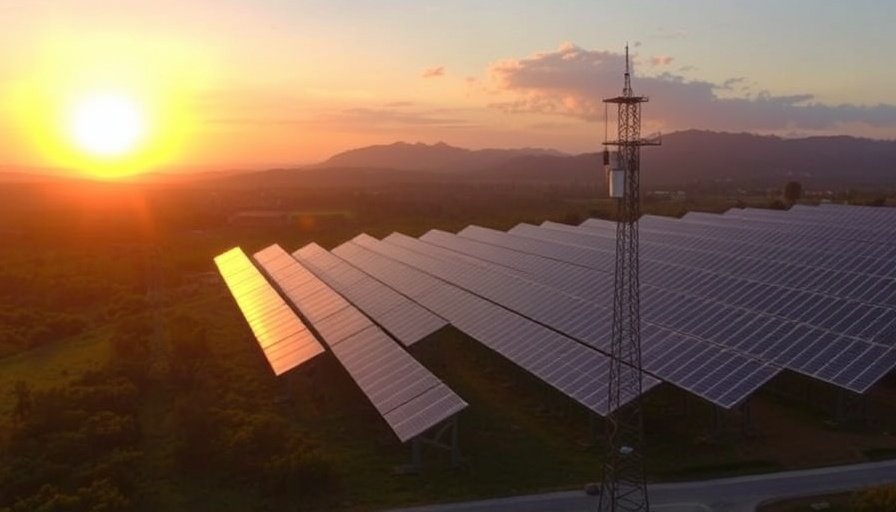
The Role of Renewable Energy in the Philippines
The Philippine MTerra Solar Project marks a significant step toward a cleaner, more sustainable energy future for the country. As the largest operating solar facility in the Philippines with an already impressive capacity of 778 megawatts, the project is on track to reach a total of 3,500 megawatts. The integration of this renewable energy source is timely, especially considering the region's struggle with soaring electricity costs that stem from reliance on imported fossil fuels and an inadequate infrastructure to support swift energy transitions.
Construction Challenges Highlight Infrastructure Gaps
Officials at the Philippine Energy Regulatory Commission (ERC) recently approved a substantial P14.25-billion ($250 million) transmission network that will connect the MTerra Solar Project to the national grid. However, the ERC also raised concerns regarding the readiness of the new substations necessary to manage the anticipated energy output, which may not be operational until 2031-2040. This acknowledgment indicates a pressing issue in the nation's planning for energy infrastructure—one that often lags behind the rapid developments initiated by private companies. Temporary connections will be employed until the permanent facilities become available, showcasing the urgent need for enhanced coordination between public entities and private energy developers.
Financial Implications for Consumers
This project not only addresses environmental concerns but is also poised to provide considerable economic relief for consumers. The solar farm will sell 850 megawatts of energy directly to Meralco under a long-term contract priced strategically to be lower than existing fossil fuel alternatives. By harnessing solar energy, which comes at no additional cost once set up, the Philippines can partiality shield its consumers from the volatility associated with international fuel prices. This move is crucial in fostering a scenario where households no longer feel the burden of spikes in fuel costs, especially during global commodity events.
Operational Benefits and Upgrades to the Power System
The anticipated benefits don't stop at cost-saving. The project includes a robust 4,500 megawatt-hour battery storage system designed to offset the limitations of solar energy, which typically wanes after sunset. This storage capability is vital, especially in the context of the Philippine power system, which historically suffers from brownouts during peak demand, particularly in the intensely hot months when supply may drastically lag behind consumer demand. By maintaining energy reserves to be deployed during high-demand hours, MTerra tackles a chronic vulnerability of existing energy setups.
Environmental Impact and Emissions Reduction
With the potential to prevent 4.3 million tons of carbon dioxide emissions annually, the MTerra Solar Project will massively contribute to the global fight against climate change. This impact is equivalent to removing over 3 million cars from the roads, significantly benefiting a nation already grappling with the adverse effects of climate change, including strong typhoons and rising sea levels. As energy capacity builds through solar, emissions related to fossil fuel consumption can dwindle, allowing the Philippines to align itself with international climate commitments while fostering domestic resilience.
A Community-Centric Initiative
Beyond energy provision, the MTerra project also emphasizes community development. The initiative has already created over 9,500 jobs during the construction phase, contributing to local economic stability in areas where employment opportunities are scarce. Additionally, through programs like TERRAnsform, Terra Solar is committed to training local workers in green energy technologies, facilitating long-term career paths that go hand-in-hand with environmental sustainability. Such initiatives underscore the holistic approach taken in executing this vital energy project, marrying economic gains with environmental stewardship.
Future Perspectives
As the MTerra Solar Project approaches its operational goals, it stands as a litmus test for the Philippines’ ability to pivot toward renewable energy sources at a scale large enough to affect both consumer costs and power reliability. The approval to connect to the national grid removes a significant regulatory hurdle and places the project at the center of the nation’s energy agenda. However, the race to finalize infrastructure remains paramount. By early 2026, when the project aims to be fully operational, the Philippines could take a pivotal step in reshaping its energy landscape and moving closer to energy independence.
 Add Row
Add Row  Add
Add 




Write A Comment